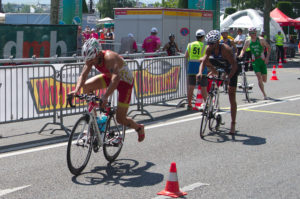 You’ve been training up a storm all winter/ spring, but the chances are, you’ve spent significantly less time thinking about your transitions than you have about the swim, bike, and run. If so, you’re like most busy, over-committed triathletes. But, T1 and T2 are enormously profitable opportunities to gain free speed and can shave minutes off your overall race time—the same minutes you’ve been training for hours to whittle down. Here are a few triathlon transition tips to live by:
You’ve been training up a storm all winter/ spring, but the chances are, you’ve spent significantly less time thinking about your transitions than you have about the swim, bike, and run. If so, you’re like most busy, over-committed triathletes. But, T1 and T2 are enormously profitable opportunities to gain free speed and can shave minutes off your overall race time—the same minutes you’ve been training for hours to whittle down. Here are a few triathlon transition tips to live by:
1) VISUALIZE every detail of both transitions. Make a mental inventory and return to this three or more times before every race. This should include marking the entrances and exits (swim out/ bike out/ bike in/ run out). Of course, the actual set up of each race will differ. You may not have a visual memory of those from previous years, but get creative in your mind as you visualize yourself engaged in each step/ gesture of the process.
2) CUT THE CLUTTER. Take only the most essential items into the transition area. Many athletes take way too many things with them. While it is excellent to be prepared for last-minute hiccups (an extra pair of goggles, a backup pair of cycling shoes, a pump, weather-specific options for clothing etc), leaving the bigger items in your car can mean a streamlined and clean transition area that will give you quick access.
3) TRI-SPECIFIC GEAR: While not required, there are a few things specific to the sport that definitely make for a more efficient T1 and T2.
*Elastic laces are perhaps the MOST time-saving for your buck, but be sure to practice running hard in them before race day.
* Going sock-less on the shorter events is definitely worth getting used to. This too requires adaptation and practice but can save upwards of 30 seconds. However, blisters are not fun, and a bad one can significantly detract from your performance. If you are prone to getting them, take the extra time to put on short socks, particularly for a half or full iron distance event. Sock-less hack: smear a thick coat of Vaseline inside your shoe where your individual pressure points are. Some people also use baby powder.
*Race belt: using a race belt with easy and effective snaps to attach your number is always better than pinning it to your kit.
4) AFFIX NUTRITION TO YOUR BIKE. Using a bento box to carry your fuel or otherwise affixing it to your bike can save you from having to fish for those items and stuff them into kit pockets in transition. The less you have to fumble for anything the better. You can also tape the tear-off tops of gels to your frame or squeeze all gels into a single flask for a quick, single grab.
5) PRACTICE MAKES PERFECT. Before the season starts, it’s worth booking one hour off to practice transitions exclusively. In that time, you can time yourself getting out of your wetsuit fast (so you have a benchmark), and then practice getting your helmet, bike shoes and glasses on quick. If leaving your bike shoes on your bike is an option for you, doing so can save a chunk of precious seconds providing that your pedal strokes off the mount line aren’t too hindered by strapping your feet in. If they are, putting your shoes on first might be the best option for you. Practice leaving your bike shoes ON your bike for T2. There is less fuss involved with taking your feet out of your shoes and leaving them on the bike than putting your feet into shoes that have been left clipped into your pedals out of T1. Practice racking your bike fluidly and then taking off your helmet, slipping on your runners, and quickly running out of your makeshift transition area. You should be able to repeat this process a few times in an hour.
For your wetsuit/ T1: You should not have to sit down to take it off. Use every open water swim as a T1 practice including running out of the calf and ankle-high water smoothly. This too takes practice.
Most importantly, bring attention to your transitions. Staying relaxed and following a plan will keep transitions effective and efficient.